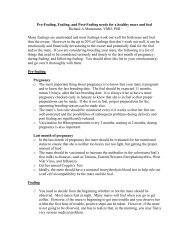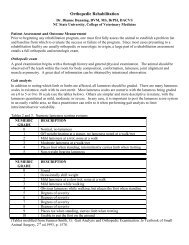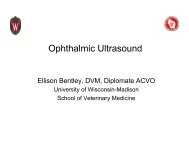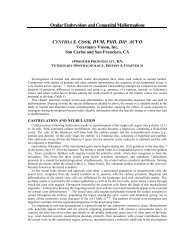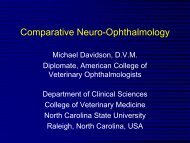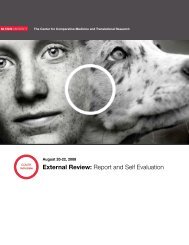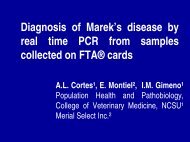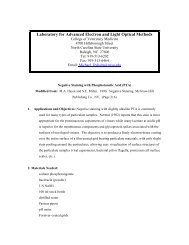ACVIM Consensus Statements - North Carolina State University ...
ACVIM Consensus Statements - North Carolina State University ...
ACVIM Consensus Statements - North Carolina State University ...
Create successful ePaper yourself
Turn your PDF publications into a flip-book with our unique Google optimized e-Paper software.
<strong>ACVIM</strong> <strong>Consensus</strong> <strong><strong>State</strong>ments</strong><br />
J Vet Intern Med 2006;20:422–434<br />
<strong>Consensus</strong> <strong><strong>State</strong>ments</strong> of the American College of Veterinary Internal Medicine (<strong>ACVIM</strong>) provide veterinarians with guidelines<br />
regarding the pathophysiology, diagnosis, or treatment of animal diseases. The foundation of the <strong>Consensus</strong> <strong>State</strong>ment is evidencebased<br />
medicine, but if such evidence is conflicting or lacking, the panel provides interpretive recommendations on the basis of their<br />
collective expertise. The <strong>Consensus</strong> <strong>State</strong>ment is intended to be a guide for veterinarians, but it is not a statement of standard of<br />
care or a substitute for clinical judgment. Topics of statements and panel members to draft the statements are selected by the<br />
Board of Regents with input from the general membership. A draft prepared and input from Diplomates is solicited at the Forum<br />
and via the <strong>ACVIM</strong> Web site and incorporated in a final version. This <strong>Consensus</strong> <strong>State</strong>ment was approved by the Board of<br />
Regents of the <strong>ACVIM</strong> before publication.<br />
<strong>ACVIM</strong> Small Animal <strong>Consensus</strong> <strong>State</strong>ment on Lyme Disease in<br />
Dogs: Diagnosis, Treatment, and Prevention<br />
Meryl P. Littman, Richard E. Goldstein, Mary A. Labato, Michael R. Lappin, and George E. Moore<br />
The purpose of this report is to offer a consensus opinion of <strong>ACVIM</strong> diplomates on the diagnosis, treatment, and prevention<br />
of Borrelia burgdorferi infections in dogs (canine Lyme disease). Clinical syndromes known to commonly be associated with<br />
canine Lyme disease include polyarthritis and glomerulopathy. Serological test results can be used to document exposure to B.<br />
burgdorferi but not prove illness. Although serum enzyme-linked immunosorbent assay/indirect fluorescent antibody assay<br />
titers can stay positive for months to years after treatment, quantitative C6 peptide antibody paired tests need more study.<br />
Serological screening of healthy dogs is controversial because it can lead to overdiagnosis or overtreatment of normal dogs,<br />
most of which never develop Lyme disease. However, serological screening can provide seroprevalence and sentinel data and<br />
stimulate owner education about tick infections and control. Although it is unknown whether treatment of seropositive<br />
healthy dogs is beneficial, the consensus is that seropositive dogs should be evaluated for proteinuria and other coinfections<br />
and tick control prescribed. Tick control can include a product that repels or protects against tick attachment, thereby helping<br />
to prevent transmission of coinfections as well as Borrelia spp. Seropositive dogs with clinical abnormalities thought to arise<br />
from Lyme disease generally are treated with doxycycline (10 mg/kg q24h for 1 month). Proteinuric dogs might need longer<br />
treatment as well as medications and diets for protein-losing nephropathy. The <strong>ACVIM</strong> diplomates believe the use of Lyme<br />
vaccines still is controversial and most do not administer them. It is the consensus opinion that additional research is needed<br />
to study predictors of illness, ‘‘Lyme nephropathy,’’ and coinfections in Lyme endemic areas.<br />
Key words: Arthritis; Borrelia burgdorferi; Glomerulonephritis; Polyarthropathy; Retriever.<br />
Borrelia burgdorferi (Bb) is a tickborne organism<br />
associated with illness in humans in Lyme, Connecticut<br />
in 1975, and the clinical syndrome was termed<br />
Lyme disease. 1–3 The organism is transmitted by Ixodes<br />
ticks, the life cycle of which has been reviewed<br />
extensively. 4 These field ticks have a 2-year life cycle<br />
and mostly quest on vegetation in prime suburban real<br />
From the Department of Clinical Studies–Philadelphia, <strong>University</strong><br />
of Pennsylvania School of Veterinary Medicine, Philadelphia, PA<br />
(Littman); Department of Clinical Sciences, College of Veterinary<br />
Medicine, Cornell <strong>University</strong>, Ithaca, NY (Goldstein); Department<br />
of Clinical Sciences, Tufts <strong>University</strong>, Cummings School of<br />
Veterinary Medicine, N Grafton, MA (Labato); Department of<br />
Clinical Sciences, Colorado <strong>State</strong> <strong>University</strong>, Ft Collins, CO<br />
(Lappin); and Department of Veterinary Pathobiology, School of<br />
Veterinary Medicine, Purdue <strong>University</strong>, West Lafayette, IN<br />
(Moore).<br />
Presented in part at the 23rd Annual Veterinary Medical Forum,<br />
American College of Veterinary Internal Medicine, Baltimore, MD,<br />
June 1–4, 2005.<br />
Reprint requests: Dr Meryl P. Littman, Department of Clinical<br />
Studies, <strong>University</strong> of Pennsylvania School of Veterinary Medicine,<br />
3900 Delancey Street, Philadelphia, PA 19104-6010; e-mail:<br />
merylitt@vet.upenn.edu.<br />
Copyright E 2006 by the American College of Veterinary Internal<br />
Medicine<br />
0891-6640/06/2002-0032/$3.00/0<br />
estate. Although Bb infection of dogs occasionally can<br />
be transmitted transplacentally 5 or by blood, 6–8 urine, 7,9–11<br />
or milk, 12 tickborne transmission is considered most<br />
common.<br />
Because of its association with a tick vector, the<br />
prevalence of Lyme disease varies geographically. The<br />
current presumed distribution of Bb in humans is shown<br />
in Figure 1. Clinical illness from Bb was first suggested<br />
in dogs in 1984 and 1985. 13,14 Since those initial reports,<br />
hundreds of manuscripts concerning Bb in dogs have<br />
been written. The combination of this increased<br />
knowledge with the introduction and common use of<br />
commercially available serological tests and vaccines has<br />
resulted in many questions about canine Bb infection in<br />
veterinary medicine.<br />
Because of the large number of questions and<br />
disparity of opinions concerning canine Lyme disease,<br />
the need for a <strong>Consensus</strong> <strong>State</strong>ment was suggested<br />
during the Infectious Disease Study Group (IDSG)<br />
meeting at the 21st Annual <strong>ACVIM</strong> Forum in 2003.<br />
During the 22nd Annual <strong>ACVIM</strong> Forum in 2004 in<br />
Minneapolis, the IDSG sponsored an evening Special<br />
Interest Group presentation and discussion led by Drs<br />
Meryl Littman, Richard Goldstein, and Edward<br />
Breitschwerdt. The <strong>ACVIM</strong> Board then selected the<br />
topic for a Small Animal <strong>Consensus</strong> <strong>State</strong>ment and<br />
chose the chairperson (Littman). During 2004–2005, the
Fig 1. National Lyme disease risk map with 4 categories of risk.<br />
(From the CDC website www.cdc.gov/ncidod/dvbid/lyme/<br />
index.htm).<br />
other panelists were chosen, reviewed the literature,<br />
shared opinions on the structure of the <strong>Consensus</strong><br />
<strong>State</strong>ment, and drafted a questionnaire that was<br />
distributed to <strong>ACVIM</strong> small animal diplomates via an<br />
e-mail listserve. Of the 45 respondents, 26 worked in<br />
endemic areas, 15 worked in nonendemic areas, and 4<br />
worked in ‘‘low-risk’’ areas. Of the respondents, 21<br />
worked in academic practice, 23 in private practice, and<br />
1 in both types of practices. The majority of the<br />
respondents had mainly a referral caseload (31) or<br />
a well-mixed caseload (11); only 2 saw mostly primary<br />
care cases. The responses received were used by the<br />
committee to aid in formatting the <strong>Consensus</strong> <strong>State</strong>ment<br />
draft that was presented orally at the 23rd <strong>ACVIM</strong><br />
Forum in Baltimore, MD, in June 2005. The written<br />
draft then was posted on the <strong>ACVIM</strong> website for<br />
additional comments by the general membership before<br />
submission of the revised manuscript to the <strong>ACVIM</strong><br />
Board of Regents and to the editors of the Journal of<br />
Veterinary Internal Medicine. The authors are aware<br />
that cases seen by specialists in referral centers might not<br />
represent the same type of cases seen primarily in the<br />
field. The panelists endeavored to use the literature and<br />
other information gathered to present evidence-based<br />
justification for issues for which there appeared to be<br />
a consensus. For issues without clear consensus, pros<br />
and cons are presented. The questions addressed<br />
primarily the diagnosis, treatment, and prevention of<br />
canine Lyme disease.<br />
1. What Clinical Syndromes are Associated with<br />
Experimental Infection of Dogs with Bb?<br />
Most people exposed to Bb show clinical signs,<br />
including an acute illness (flulike signs, erythema<br />
migrans rash), subsequent arthritis, and possibly cardiac,<br />
neurologic, or chronic skin changes; only 10% are<br />
asymptomatic. 1–3 In contrast, 95% of exposed dogs<br />
remain asymptomatic. 15 For Lyme disease in dogs,<br />
Koch’s postulates have only been satisfied for a syndrome<br />
of transient fever, anorexia, and arthritis, which<br />
was detected only in puppies. Experimentally, after<br />
putting Ixodes ticks from New York on Beagles, the<br />
Lyme Disease <strong>Consensus</strong> <strong>State</strong>ment 423<br />
adult dogs seroconverted but remained asymptomatic<br />
9,16,17 ; however, 6–12-week-old puppies showed oligoarthropathy<br />
in the limb closest to the tick bites with or<br />
without lymphadenopathy, about 2–5 months after<br />
exposure. 9,18–24 The illness was self-limiting and resolved<br />
in 4 days without treatment. Some puppies developed<br />
several similar episodes in the same or different leg a few<br />
weeks apart, which also were self-limiting. Tissue<br />
migration is more likely than hematogenous spread in<br />
the dog; the first leg to show lameness was the limb<br />
closest to where the ticks were attached. 18 Older pups<br />
(12–26 weeks old) were affected less often and only for<br />
1–2 days. 25,26 Cytological assessment of synovial fluid<br />
collected by arthrocentesis showed neutrophilic inflammation.<br />
9,13,14 One study suggested that chronic Lyme<br />
infection might lead to degenerative joint disease<br />
because carrier pups in which postmortem examinations<br />
were performed later in life had asymptomatic mild<br />
nonsuppurative synovial infiltration 9 ; however, the same<br />
synovial changes were found in seronegative and<br />
vaccinated dogs. 27 In small numbers of field cases, renal,<br />
cardiac, neurologic, or dermatologic manifestations<br />
have been attributed to Bb infection of dogs, but these<br />
syndromes have not been reproduced in experimental<br />
models. At the Matthew J. Ryan Veterinary Hospital of<br />
the <strong>University</strong> of Pennsylvania (Ryan VHUP), 55% of<br />
retrievers with thrombocytopenia were seropositive for<br />
Bb antibodies compared with 24% of healthy retrievers,<br />
but this association could be because of coinfections (see<br />
question 7) or thrombocytopenia might be associated<br />
with nephropathy (see question 4) (Littman, personal<br />
communication).<br />
2. How Common is Lyme Arthropathy in Dogs in<br />
Clinical Practice?<br />
This question is difficult to answer because there are<br />
so many seropositive dogs in endemic areas, there is no<br />
test result that proves illness from Bb infection, and<br />
some dogs thought to be subclinically infected could be<br />
ill from another cause. For example, there are Lyme<br />
endemic areas where 70–90% of all healthy and clinically<br />
ill dogs are seropositive, 28–30 making the diagnosis of<br />
Lyme disease in individual dogs problematic. In another<br />
study, fewer than 5% of seropositive dogs showed<br />
lameness during a 20-month observation period, and<br />
the same was true for seronegative dogs. 15 At Ryan<br />
VHUP, 37% of the general population and 57% of the<br />
polyarthropathy dogs were Lyme-positive. 31 Breed predisposition<br />
also could be involved because 57% of lame<br />
retrievers compared with 24% of healthy retrievers were<br />
seropositive, but there was no such difference in<br />
seropositivity between nonlame and lame German<br />
Shepherds at Ryan VHUP (Littman, personal communication).<br />
3. Has ‘‘Lyme Nephropathy’’ Been Definitely<br />
Associated with Bb Infection of Dogs?<br />
Although there is no experimental model for Lyme<br />
nephropathy and Koch’s postulates are not satisfied,
424 Littman et al<br />
there are multiple reports of dogs with Bb antibodies<br />
developing a unique renal histopathologic lesion, including<br />
immune-mediated glomerulonephritis, diffuse<br />
tubular necrosis and regeneration, and lymphocyticplasmacytic<br />
interstitial nephritis. 11,30,32,33,a About 30%<br />
had a history of arthritis and almost 30% had a history<br />
of Lyme vaccination. Labrador Retrievers, Golden<br />
Retrievers and Shetland Sheepdogs have been overrepresented<br />
in some studies (Sanders, personal communication).<br />
32 Dogs with Lyme-associated protein-losing<br />
nephropathy (PLN) are younger than dogs with PLN<br />
from other causes. 32 Positive staining for Lyme antigens<br />
in canine renal tissue of dogs with this nephropathy were<br />
found with monoclonal antibody stains, 11,30,32 and the<br />
agent was isolated in urine, 11 but a causal relationship<br />
still is not proven.<br />
4. What are the Clinical and Laboratory<br />
Abnormalities Associated with<br />
Lyme Nephropathy?<br />
Most reported cases 11,30,32,33,a of Lyme nephropathy<br />
are clinically ill dogs presented mostly in the summer or<br />
fall months with an acute or chronic presentation of<br />
renal failure with anorexia, vomiting, dehydration,<br />
variable polyuria and polydipsia, and wasting. Abnormalities<br />
included vasculitis with possible edema or<br />
effusions; hypertension with possible blindness or heart<br />
murmur; thromboembolic events (eg, pulmonary thrombosis<br />
with dyspnea; saddle thrombus with hind limb<br />
weakness); and sometimes neurologic signs (eg, seizure,<br />
nystagmus, collapse) from vasculitis, hypertension,<br />
thromboembolic events, uremic encephalopathy, or<br />
meningitis. Laboratory abnormalities in this syndrome<br />
included nonregenerative anemia, stress leukogram,<br />
thrombocytopenia, hypoalbuminemia, azotemia, hypercholesterolemia,<br />
hyperphosphatemia, and sometimes hyperkalemia<br />
and hyperbilirubinemia. Urinalysis showed<br />
proteinuria and possible decreased concentrating ability<br />
with hemoglobinuria, hematuria, glucosuria, bilirubinuria,<br />
casts, and an active sediment with negative<br />
bacterial culture. Many dogs succumb within days to<br />
weeks, some with oliguric or anuric renal failure.<br />
5. Is the Cause of Lyme Nephropathy Known?<br />
Lyme nephropathy probably is an immune-mediated<br />
phenomenon b and might depend on the strain of Bb, the<br />
genetic predisposition of the patient, and possibly other<br />
triggers. The incidence of PLN associated with Lyme<br />
disease still is unknown. At Ryan VHUP, presence of Bb<br />
antibodies was not associated with proteinuria (ie, urine<br />
protein–to–creatinine ratio . 1) in the general hospital<br />
population (Murray, personal communication); however,<br />
the seroprevalence of Bb antibodies in healthy<br />
retrievers and retrievers with PLN was 24 and 85%,<br />
respectively (Littman, personal communication). Occult<br />
proteinuria was detected infrequently in young healthy<br />
Bb-seropositive Labrador and Golden Retrievers at<br />
Cornell. c In addition, proteinuria was not associated<br />
with presence of Bb antibodies in Bernese Mountain<br />
dogs or control dogs in Europe. d It currently is<br />
unknown why some dogs develop nephropathy and<br />
others do not.<br />
6. Why do Findings from Experimental Studies<br />
and Clinical Practice Vary for Lyme Disease?<br />
It is not known why experimental studies fail to<br />
replicate what is presumed to occur in naturally<br />
occurring cases in veterinary practices. However, differences<br />
might relate to breed predispositions, different<br />
strains of Bb in the field, the likelihood for multiple<br />
exposures in pets, and the presence of coinfections.<br />
7. What are the Other Differential Diagnoses or<br />
Coinfections in Dogs Suspected to Have<br />
Lyme Disease?<br />
Dogs with fever, lameness and anorexia or proteinuria<br />
(with or without azotemia) could have many<br />
other infectious, immune-mediated, or neoplastic causes,<br />
and the clinician should consider all other differential<br />
diagnoses (Fig 2). Owners are very willing to accept<br />
a popular diagnosis such as ‘‘Lyme disease,’’ but the<br />
clinician should be aware that dogs sick with any illness<br />
can be seropositive just by coincidence. Because<br />
specialists are seeing primarily sick referral cases, there<br />
might be bias against Lyme disease as a serious entity<br />
causing morbidity. Primary practitioners could be seeing<br />
more cases that are mild, self-limiting, or easily treated<br />
with a short course of antibiotics that do not require<br />
referral. Referred dogs with ‘‘nonresponsive Lyme<br />
disease’’ often are found to have other illnesses.<br />
Because Bb is tick-associated, coinfections commonly<br />
are those that share the same vector or are associated<br />
with other ticks, fleas, or environmental exposure<br />
including Anaplasma phagocytophilum, Ehrlichia spp.,<br />
Rickettsia rickettsii, Neorickettsia risticii, Bartonella<br />
spp., Babesia spp., Mycoplasma spp., and Leptospira<br />
spp. Ixodes ticks can carry many organisms, including<br />
Bb, A phagocytophilum, Babesia microti, Bartonella spp.,<br />
tickborne encephalitis virus, and possibly others. In<br />
experimental studies with ticks from Westchester County,<br />
NY, coinfections with A phagocytophilum were found<br />
in 32–45% of the dogs. 19,26 In 2001, 40% of Bb<br />
seropositive (and 6.6% of seronegative) dogs also were<br />
seropositive for antibodies against A phagocytophilum<br />
(up from 15.6 and 0%, respectively, in 1985). 34 B microti<br />
coinfections with Bb also were found in dogs with New<br />
York ticks in experimental Lyme studies. 9 In dogs, a B<br />
microti–like piroplasm (possibly Theileria) can cause<br />
PLN and thrombocytopenia. 35 Infections and coinfections<br />
with A phagocytophilum, B microti, and Bartonella<br />
spp. have complicated Lyme disease syndromes in<br />
humans. 36–39 When coinfections were induced in experimentally<br />
infected dogs, 26 a trend showed an increased<br />
frequency of lameness (53%) in dogs coinfected with A<br />
phagocytophilum and Bb 19 over dogs with Bb infection<br />
alone (29%). Coinfected dogs might be more likely to<br />
have arthritic signs (as seen in mice coinfected with A<br />
phagocytophilum and Bb 40 or B microti and Bb 41 ) and
possibly other manifestations, such as PLN, ocular<br />
inflammation, neurologic signs, or thrombocytopenia.<br />
Specific diagnostic tests are required for documentation<br />
of these infections.<br />
8. How is Canine Lyme Disease Diagnosed?<br />
No individual test result documents clinical illness<br />
from Bb infection. Thus, the presumptive diagnosis of<br />
Lyme disease should include (1) evidence of exposure to<br />
Bb, (2) clinical signs consistent with Lyme disease, (3)<br />
consideration of other differentials, and hopefully (4)<br />
response to treatment. Evidence of exposure to Bb<br />
generally includes Ixodes tick exposure in an endemic<br />
area for Lyme or positive test results in tests for Bb (see<br />
question 9). Endemic areas for Lyme disease in people<br />
have been mapped by the Centers for Disease Control<br />
(see Fig 1). In 2003, just 12 states (PA . NY . NJ .<br />
MA . CN . RI . WI . MD . MN . DE . VA .<br />
NH) accounted for 95% of cases, with 89% of the cases<br />
occurring in the <strong>North</strong>east and mid-Atlantic region and<br />
6% in the upper Midwest. 42 Presence of deer is not<br />
required for exposure; migratory birds such as robins<br />
can carry Ixodes ticks to previously naïve areas. 43,44<br />
Lyme Disease <strong>Consensus</strong> <strong>State</strong>ment 425<br />
Fig 2. Flowchart for lameness, with or without fever or anorexia, and Lyme seropositivity and proteinuria. 56<br />
9. What Tests are Available to Evaluate for<br />
Bb Infection?<br />
Tests for Bb can be divided into those that<br />
demonstrate presence of the organism and antibody<br />
tests. Detection of the organism by culture, cytology, or<br />
polymerase chain reaction (PCR) assay can be difficult,<br />
expensive, and not readily available in practice. The<br />
organism is very rarely found in blood, urine, joint fluid,<br />
or CSF 7 ; it is more often found in connective tissue,<br />
synovia, skin, or fibroblasts. The organism is difficult to<br />
culture, 45 and special stains (eg, silver, acridine orange)<br />
or dark-field microscopy are required to visualize Bb.<br />
Plasmid or chromosomal genomic DNA of Bb can be<br />
amplified by PCR primers for the outer surface protein<br />
A (OspA) gene or 23S RNA gene. 26 However, positive<br />
PCR test results, especially with target imbalance (OspA<br />
versus 23S RNA), do not prove the organism is alive and<br />
could be a result of leftover fragments or ‘‘blebs,’’ which<br />
are nonviable. 46 Also, the organism might exist in other<br />
forms (eg, L-forms, spheroplasts, cysts). 47–55 Because<br />
documentation of the organism is problematic, serologic<br />
tests for antibodies against the agent usually are<br />
performed.
426 Littman et al<br />
10. What Antibody Tests for Bb Currently<br />
are Available?<br />
Historically, serum antibodies against Bb have been<br />
detected by enzyme-linked immunosorbent assays (ELI-<br />
SAs), indirect fluorescent antibody assays (IFAs), and<br />
Western blot immunoassays made with a variety of Bb<br />
antigen preparations. ELISA and IFA antibody responses<br />
to antigen preparations could not when first<br />
reported differentiate antibodies resulting from natural<br />
exposure to Bb from those associated with vaccination<br />
or infection because of other Borrelia spp. In those<br />
cases, banding patterns on Western blot immunoassay<br />
were used to differentiate the source of the antibody<br />
response. The OspA antigen generally is only expressed<br />
in the tick and during in vitro culture (and so it is present<br />
in Lyme vaccines), but not usually in acute mammalian<br />
infections. Thus, recognition of this band (p31) generally<br />
suggests that the animal has been vaccinated, not<br />
infected. However, the banding patterns that develop<br />
after infection are complicated and changes occur as<br />
antigenic variation by the organism stimulates new<br />
antibody production. It is now known that OspA can be<br />
expressed in the mammal during the carrier, subclinical,<br />
or chronic phases of Bb infection, giving a Western blot<br />
pattern that leads to misdiagnosis. 56–58 Immunoglobulin<br />
M (IgM) and G (IgG) ELISA and IFA also are<br />
available, but there is no evidence that dogs develop<br />
clinical signs of Lyme disease early in the course of<br />
infection when only IgM is present. In addition, new<br />
IgM antibodies could be produced against new antigens<br />
expressed during antigenic variation, so that the<br />
appearance of IgM does not always prove recent<br />
exposure. The synthetic C6 peptide, derived from the<br />
VlsE antigen, is expressed when Bb is transmitted to<br />
the dog but not expressed in the tick, in tissue culture,<br />
or in Lyme vaccines. 23,59–61 Thus, antibodies against<br />
this antigen prove natural exposure. Both qualitative<br />
(SNAP-3Dx, IDEXX, point-of-care) e and quantitative<br />
(Lyme Quant C6 Test, IDEXX) f versions of the test are<br />
available. 62 Results of these tests correlate well with<br />
those from Western blot immunoassay. 63,d Positive<br />
results in either C6 antibody assay indicate exposure to<br />
Bb but do not prove clinical disease.<br />
11. When Does the Qualitative C6 Antibody<br />
Assay Become Positive in Dogs Experimentally<br />
Infected with Bb?<br />
Antibodies against C6 peptide generally can be<br />
detected 3–5 weeks after infection, well before signs<br />
were noted in the experimental model of canine Lyme<br />
disease; the test stayed positive for at least 69 weeks. 23<br />
12. Are Results from Paired Assays Needed to<br />
Diagnose Canine Lyme Disease?<br />
Because there were no signs of illness in the<br />
experimental Beagle puppy model until 2–5 months<br />
after tick exposure (well after seroconversion 9,18–25 ), the<br />
necessity of paired titers for the initial diagnosis of Lyme<br />
disease is not evident. In addition, titer magnitude is not<br />
associated with the presence or absence of disease. 15<br />
However, some of the common coinfections have a much<br />
shorter clinical course of disease, with illness occurring<br />
before seroconversion, thus necessitating paired titers to<br />
show seroconversion (eg, Ehrlichia spp., A phagocytophilum,<br />
Rocky Mountain spotted fever [RMSF]).<br />
13. What Antibiotics can be Used in the<br />
Treatment of Lyme Disease in Dogs?<br />
In humans, doxycycline, amoxicillin, and ceftriaxone<br />
are considered drugs of choice. 64,65 On the basis of<br />
extrapolation from results in humans and some research<br />
studies (see below), tetracycline derivatives or amoxicillin<br />
are recommended most frequently by veterinarians<br />
for the treatment of Lyme disease. Because different<br />
strains of Bb exist in the field and because it is difficult to<br />
diagnose Lyme disease in the field or induce clinical<br />
disease in experimentally infected dogs, the optimal<br />
drugs and duration of therapy are unknown. Most<br />
authors and <strong>ACVIM</strong> diplomates in our survey currently<br />
recommend administration of doxycycline at 10 mg/kg<br />
PO q24h for a minimum of 1 month (see Fig 3).<br />
Doxycycline was recommended most frequently because<br />
of the possibility of other coinfections (RMSF, anaplasmosis,<br />
ehrlichiosis, leptospirosis) that could respond to<br />
doxycycline and because it is inexpensive and has antiinflammatory<br />
properties. In humans, the recommended<br />
treatment for acute Lyme disease is only 10 days of<br />
doxycycline. 65 However, experimentally infected dogs do<br />
not develop clinical disease during the acute phase, 9 and<br />
the infection is likely to be more widespread than in<br />
humans that have acute Lyme disease with flulike signs<br />
or erythema migrans rash. In humans, the entity known<br />
as ‘‘chronic Lyme disease’’ is debated, and one study<br />
showed that long-term antibiotic treatment helped as<br />
much as placebo. 66 Polyarthropathy could be immunemediated<br />
and improve faster with added glucocorticoids.<br />
Dogs with presumed Lyme nephropathy might<br />
require longer duration of doxycycline therapy and<br />
usually are treated with adjunctive therapies such as<br />
angiotensin-converting enzyme inhibitors, low-dose aspirin,<br />
omega-3 fatty acids, dietary therapy, and if<br />
indicated, additional antihypertensives, fluid therapy as<br />
needed, and possible immunomodulating drug therapy.<br />
However, because there is no model for canine Lyme<br />
nephropathy, optimal therapy is unknown.<br />
14. Does Routine Antibiotic Therapy Clear Bb<br />
From the Tissues?<br />
Results of treatment studies have varied. In studies of<br />
experimentally infected dogs (clinically normal), several<br />
different antibiotics (doxycycline 10 mg/kg PO q12h;<br />
amoxicillin 20 mg/kg PO q8h, azithromycin 25 mg/kg PO<br />
q24h, or ceftriaxone 25 mg/kg IV q24h) have been<br />
administered for 1 month with failure to clear Bb from<br />
the tissues in some dogs. 18,20–22 In those studies, a few (3 of<br />
24) dogs had positive Bb culture results and many dogs<br />
had positive PCR test results on skin samples from the<br />
site of the tick bites, even a year after treatment with
Fig 3. Flowchart for the Lyme-positive dog.<br />
antibiotics. But these studies only used PCR probes for<br />
plasmid DNA and not genomic DNA 21,22 or did not state<br />
which probes were used 18,20 ; consequently, PCR results<br />
could have been a result of nonviable remnant spirochetes<br />
or blebs. These could remain immunologically active and<br />
result in maintenance of positive antibody titers but not<br />
indicate presence of live Bb. In another study, after<br />
treatment was administered and titers waned, a new rise<br />
in titers after 6 months in isolation was seen, 20 presumably<br />
because of proliferation of the surviving pool of<br />
spirochetes. However, in other studies, titers dropped and<br />
stayed low for 35 weeks 67 or more than a year posttreatment.<br />
21,22 In addition, some antibiotic-treated experimentally<br />
infected dogs with persistently positive PCR assay or<br />
skin culture results did not have recurrent clinical signs,<br />
even if treated with glucocorticoids. 18,26 Evidence for and<br />
against persistence of infection despite treatment is<br />
further reviewed elsewhere. 56 There is debate about<br />
whether ‘‘chronic Lyme disease’’ is caused by cystic<br />
forms (see question 15) that are difficult to culture,<br />
persistence of viable Bb in immunoprivileged sites,<br />
immune-mediated disease triggered by Lyme antigens,<br />
or occult coinfection or other diseases, in which case the<br />
positive Lyme test could be a coincidence.<br />
Lyme Disease <strong>Consensus</strong> <strong>State</strong>ment 427<br />
15. Is There Evidence for Antimicrobial-Resistant<br />
Strains of Bb in Dogs?<br />
It has been proposed that there are nonmotile forms<br />
of the spirochete that are resistant to antibiotics<br />
generally used. In a hostile in vitro environment (during<br />
antibiotic administration), Bb could transform into<br />
a spheroplast (L-form or cystic form), 47–55,68–70 which<br />
might be resistant to antibiotics. This transformation is<br />
more likely to occur with penicillins and ceftriaxone<br />
than with tetracyclines or macrolides. 71 When the<br />
antibiotic is stopped, the spheroplast or cyst releases<br />
new motile spirochetes. The spheroplast form might be<br />
sensitive to metronidazole 54 and hydroxychloroquine. 53<br />
16. What is the Expected Response to Treatment<br />
of Lyme Disease in Dogs?<br />
Response to treatment is expected within 1–2 days for<br />
acute Lyme arthropathy, although titers can remain<br />
positive for many months to years. The response could<br />
be the result of the self-limiting nature of the disease,<br />
inadvertent treatment of another doxycycline-responsive<br />
infection, reactive arthritis, 72 or the anti-inflammatory
428 Littman et al<br />
and antiarthritic properties of doxycycline. 73,74 However,<br />
PLN associated with Lyme disease tends to respond<br />
slowly, possibly because chronic disease changes exist<br />
before diagnosis and initiation of treatment.<br />
17. How Should Dogs Treated for Lyme Disease<br />
be Monitored?<br />
Clinical signs of disease should be monitored routinely.<br />
Although a consensus opinion was not reached, most<br />
<strong>ACVIM</strong> diplomates recommend following proteinuria in<br />
all dogs with Lyme disease (complete urinalysis, in-house<br />
E.R.D.–HealthScreen Urine Test, g or a urine protein/<br />
creatinine ratio). 75 However, the optimal recheck interval<br />
or duration is unknown. In a limited number of<br />
experimentally infected dogs, quantitative C6 antibody<br />
concentrations decreased after treatment, so evaluating<br />
pre- and 6-month post treatment quantitative C6 concentrations<br />
has been recommended by some. 62,67,76 However,<br />
information concerning quantitative C6 kinetics in untreated<br />
field cases has not been published, and the<br />
predictive value of the test for subsequent illness is<br />
unknown. In addition, a low positive titer might not<br />
disappear with treatment, perhaps because of immune<br />
memory. 77 Thus, it is the consensus opinion that this<br />
protocol cannot be routinely recommended until published<br />
data from a large number of field cases is made available.<br />
18. Should Healthy Dogs be Screened for<br />
Bb Antibodies?<br />
Whether healthy dogs should be screened for<br />
antibodies against Bb proved controversial, and a consensus<br />
could not be reached. The points that follow are<br />
those raised in the literature and in our <strong>ACVIM</strong><br />
diplomate survey that we think should be considered<br />
when clinicians are making a decision about whether to<br />
screen healthy dogs for evidence of Bb exposure. Similar<br />
discussion was presented for screening healthy dogs for<br />
Ehrlichia canis antibodies in a previous <strong>ACVIM</strong><br />
<strong>Consensus</strong> <strong>State</strong>ment. 78<br />
Potential benefits cited most frequently for serologically<br />
screening healthy dogs include:<br />
1. We might detect a potentially dangerous disease<br />
(Lyme-associated nephropathy) before clinical illness<br />
develops by screening and monitoring seropositive<br />
dogs for proteinuria. Although checking<br />
for proteinuria is part of an annual wellness<br />
examination, if a dog is known to be seropositive,<br />
one might want to check for proteinuria more<br />
frequently than annually, especially in retrievers<br />
and Shelties. (see Fig 3).<br />
2. We can track seroprevalence data in the practice<br />
area in both healthy and sick dogs.<br />
3. Our vaccination protocol can be individualized<br />
because there is no evidence that vaccine is helpful<br />
for seropositive dogs.<br />
4. We can provide information about the environment<br />
because dogs are sentinels. 79<br />
5. We can inform owners about landscaping changes<br />
and the importance of checking daily for ticks on<br />
themselves as well as their pets, and we can<br />
emphasize the importance of using tick control.<br />
6. We can inform owners that if they remove an<br />
engorged Ixodes tick from a person, they should<br />
call a physician who could prescribe 1 dose of<br />
doxycycline (200 mg) to be taken within 72 hours,<br />
which has been shown to prevent Lyme disease in<br />
people. 80 Owners are very thankful for this public<br />
health information. No such study has been done<br />
on dogs.<br />
Arguments against serologically screening healthy<br />
dogs (or treating them) that were mentioned most<br />
frequently include:<br />
1. Routine testing often results in overdiagnosis and<br />
overtreatment of dogs on the basis of a test that<br />
does not diagnose Lyme disease nor predict<br />
whether Lyme disease will ever occur; most<br />
seropositive dogs will never become ill with Lyme<br />
disease and do not need to be treated.<br />
2. Overtreatment with incomplete clearance of the<br />
organisms potentially can induce resistant strains.<br />
3. Overuse of antibiotics generally increases other<br />
microbial resistance in the environment.<br />
4. Not all dogs are cleared of infection even after<br />
1 month of antibiotics.<br />
5. Immunity is not permanent, and treated dogs could<br />
be reinfected.<br />
6. Subclinically infected seropositive dogs might be in<br />
a premunitive state that could be protective.<br />
7. Drugs used for treatment of Lyme disease have<br />
potential adverse effects.<br />
8. Detection of positive test results could cause<br />
unnecessary owner distress.<br />
9. False positive test results involve expense for the<br />
owner, unnecessary owner distress, and potential<br />
induction of drug reactions in animals that do not<br />
need to be treated.<br />
10. Lyme endemic areas are already well-known, and<br />
tick control and public health information should<br />
be recommended in all Lyme endemic areas<br />
regardless of results of blood tests.<br />
11. Screening for proteinuria should be part of<br />
a routine wellness examination and not done<br />
merely because of a seropositive test result.<br />
19. Should all Dogs with Proteinuria be Screened<br />
for Bb Antibodies?<br />
The consensus opinion is that dogs with proteinuria<br />
in endemic areas should be screened for exposure to<br />
Bb with antibody tests and that Bb seropositive<br />
dogs should be screened for proteinuria (see Fig 3).<br />
However, proteinuria has many causes. Thus, instead of<br />
screening all dogs for Bb antibodies and then<br />
screening the seropositive ones for proteinuria, it is the<br />
general recommendation that all veterinarians screen<br />
dogs for proteinuria as part of a wellness visit and<br />
then recommend a complete workup to identify the<br />
cause. 75
20. How Should a Subclinically Infected Seropositive<br />
Dog be Managed?<br />
For reasons discussed previously, the clinical course<br />
of a seropositive but apparently healthy dog cannot be<br />
predicted. The pros and cons of treatment and<br />
monitoring (see question 18) should be discussed with<br />
the owner, and a case-by-case decision should be made.<br />
In one study, seropositivity and proteinuria was not<br />
associated in young (mean age, 34 months) apparently<br />
healthy Labradors. d In another study, neither seropositivity<br />
nor titer magnitude were correlated with whether<br />
a dog would show clinical signs of arthritis over the 20month<br />
period of observation. 15 There is no evidence that<br />
vaccination of seropositive dogs (asymptomatic or<br />
symptomatic) is helpful, with either bacterin or recombinant<br />
OspA subunit (rOspA) vaccine, 81–83 and there is<br />
some potential for exacerbation of immune-mediated<br />
consequences (see question 25). Further epidemiologic<br />
studies will be needed before a consensus concerning<br />
management of healthy seropositive dogs can be made.<br />
21. What are the Pros and Cons for the Use of<br />
Vaccines Against Bb in Dogs?<br />
The many arguments for and against vaccination<br />
against Bb in dogs are summarized in Table 1. The only<br />
consensus reached is that immunization of dogs in<br />
nonendemic states is unneeded (Fig 1). The majority of<br />
respondents do not recommend Bb vaccination in<br />
endemic states either. However, which vaccine antigens<br />
are to be administered to individual animals is a medical<br />
decision that should be made between each owner and<br />
their veterinarian on an individual case basis. 87,89<br />
22. What Vaccines Currently are Available for Bb<br />
Infections of Dogs?<br />
In the United <strong>State</strong>s, 4 vaccines are currently available:<br />
(1) monovalent bacterin, h available since 1990; (2)<br />
bivalent bacterin, i available since 1994; (3) nonadjuvanted<br />
rOspA vaccine, j available since 1996; and (4)<br />
adjuvanted rOspA vaccine, k available since 1999.<br />
23. How Effective are Lyme Vaccines?<br />
Response to Lyme vaccination can be measured by<br />
determining how many vaccinated dogs become ill<br />
(preventative fraction for disease) or by determining<br />
how many vaccinated dogs seroconvert (preventative<br />
fraction for seroconversion). In one study, 84 use of the<br />
monovalent bacterin resulted in an average preventive<br />
fraction for illness of 78% (58% in seropositive and 86%<br />
in seronegative dogs). In a separate study, preventive<br />
fraction for seroconversion was roughly 90% for the<br />
monovalent bacterin and 60% for the rOspA vaccine. 85<br />
Unfortunately, in these studies, 84,85 dogs were not<br />
evaluated for Bb exposure before vaccination, complicating<br />
the interpretation of the data presented. Studies<br />
evaluating preventative fraction for disease are probably<br />
of most value but are marred by the difficulties<br />
Lyme Disease <strong>Consensus</strong> <strong>State</strong>ment 429<br />
associated with making an accurate diagnosis of Lyme<br />
disease. OspA antigen is present in both bacterins and<br />
the rOspA vaccine. The anti-OspA antibodies generated<br />
by vaccination kill Bb within the tick. Bacterins have<br />
been purported to stimulate anti-OspC antibodies as<br />
well as anti-OspA antibody titers; thus, the preventive<br />
efficacy of a bacterin might be greater than for the<br />
subunit vaccine. However, anti-OspC antibody bands<br />
are rarely seen on Western blot tests from dogs<br />
vaccinated with bacterins (Goldstein, personal communication).<br />
Because bacterin contains more types of<br />
antigens, there might be more risk for immune-mediated<br />
reactions and adverse effects.<br />
24. If a Lyme Vaccine is Going to be Administered,<br />
What is a Common Protocol?<br />
Because an enhanced benefit is possible in animals<br />
immunized before exposure, some recommend administration<br />
of the vaccines before exposure occurs. In this<br />
scenario, puppies initially would be vaccinated at 9 or<br />
12 weeks of age with a 2nd dose administered 2–4 weeks<br />
later, followed by annual boosters, preferably in the<br />
spring before tick exposure. Duration of immunity<br />
against Bb is short, and annual boosters would be<br />
needed. 90<br />
25. What Adverse Effects are Associated with<br />
Administration of Lyme Vaccines?<br />
It has been estimated that administration of Lyme<br />
vaccine is associated with ,2% adverse effects. 84 Because<br />
Lyme arthropathy and Lyme nephropathy arise at least<br />
in part from immune responses against the organism,<br />
there are concerns that vaccination might contribute to<br />
the immunopathogenesis of disease in some dogs. This<br />
sensitization has been demonstrated for other organisms,<br />
including feline infectious peritonitis virus, caprine<br />
encephalitis virus, and ovine visna-maedi virus. 91 In<br />
humans, antibodies against several Bb antigens react<br />
with several autoantigens (ie, molecular mimicry),<br />
including lymphocyte function–associated antigen 1<br />
(LFA-1), myelin, myosin, cardiolipin, and thyroid, 92–95<br />
which has complicated the use of Lyme vaccines in<br />
people. The development of a Lyme bacterin for humans<br />
was considered too risky and was discontinued. The<br />
human subunit OspA vaccine was launched in December<br />
1998 but was taken off the market in February 2002<br />
because of poor sales. There were concerns about<br />
possible immune-mediated sequelae in people with<br />
HLA-DR4 haplotype, who are predisposed to chronic<br />
nonresponsive Lyme disease, which might be triggered<br />
by OspA mimicry of LFA-1. 92,96–99 A new, potentially<br />
safer 2nd-generation vaccine for humans that excludes<br />
the cross-reactive epitope is being studied. 100 OspA has<br />
been shown to be proinflammatory and sensitizing in rat<br />
and hamster models of Lyme arthritis, causing them to<br />
have more severe signs upon challenge or re-exposure.<br />
92,101–107 Nonviable spirochetes trigger the production<br />
of inflammatory cytokines in dogs. 24,27 Almost 30%<br />
of dogs with putative Lyme nephropathy had been
430 Littman et al<br />
vaccinated. 32 OspA was found in the renal cortex of dogs<br />
with Lyme nephropathy with the use of a mouse<br />
monoclonal anti-OspA stain. 11,30 OspA is not yet proven<br />
to be the antigen involved in immune complex deposition<br />
in glomeruli but Lyme-associated nephropathy<br />
is an immune complex disease. b At Ryan VHUP, a dog<br />
with Lyme nephropathy that became very ill a few days<br />
after its 2nd rOspA vaccine was described (Fincham,<br />
personal communication). The Western blot and SNAP<br />
tests showed no evidence of natural exposure, but a very<br />
high anti-OspA antibody concentration was detected.<br />
Because OspA is in both bacterins and rOspA vaccines,<br />
there is concern about whether it could trigger, sensitize,<br />
or add antigens to antigen-antibody immune complex<br />
Table 1. Pros and cons of Lyme vaccination.<br />
Proponents Say … Naysayers Say…<br />
Private practitioners have given many doses of Bb vaccines 39 diplomates do not recommend vaccine, only 2 recommend vaccine,<br />
since 1990 without side effects.<br />
and 4 use it rarely.<br />
Because you might not always clear the infection and some Most Bb infections are subclinical or respond rapidly to cheap/safe/oral<br />
dogs get serious illness from Bb, it is best to attempt to antibiotics. The dogs that develop serious illness from Bb are<br />
prevent infection with vaccination.<br />
probably genetically predisposed to having immune-mediated disease<br />
triggered by Lyme antigens and vaccine might not be best for them.<br />
Owners might not want to use tick control products and prefer We need to use good tick control in Lyme endemic areas anyway because<br />
a vaccine. Owners are worried about Lyme disease in their<br />
area.<br />
of Anaplasma, RMSF, Ehrlichia, Babesia, Bartonella spp., etc.<br />
Private practitioners using vaccine say they are seeing fewer<br />
Lyme disease cases now.<br />
Practitioners not using vaccine are also seeing fewer Lyme disease cases.<br />
Efficacy Efficacy<br />
N Bacterin preventive fraction for illness 5 78% 84<br />
N Bacterin preventive fraction for seroconversion 5<br />
90% 85 or 92% 61<br />
N rOspA 100% efficacious 86<br />
N Need annual boosters (economic incentive)<br />
N Variable, 50–100%<br />
N Not that good for preventing signs<br />
N Preventive fraction for illness is more important than preventing<br />
seroconversion<br />
N rOspA only 50% efficacious 27<br />
N rOspA only 60% efficacious 85<br />
N Need annual boosters<br />
Safety Safety (see text for more references)<br />
N ,2% adverse effects 84<br />
N ‘‘Post-vaccinal Lyme-like syndrome’’ might be a<br />
result of misinterpretation of Western blots<br />
(carrier dogs’ patterns can appear as those<br />
vaccinated with bacterin), Anaplasma infection, or<br />
other causes.<br />
Treat all positive dogs with doxycycline for 1 month and<br />
vaccinate with bacterin at 0, 14 days. 34<br />
N Possible anaphylaxis; adverse effects are ‘‘moderate’’ 87<br />
N ‘‘Post-vaccinal Lyme-like syndrome’’ 88 needs more study<br />
N Many respondents associated adverse effects (PLN, IMPA) with<br />
Lyme vaccines<br />
N Molecular mimicry<br />
# OspA/LFA-1 (HLA-DR4 predisposed)<br />
# Myelin, myosin, cardiolipin, thyroid<br />
N OspA is in all vaccine types<br />
# OspA is proinflammatory<br />
# OspA sensitizes<br />
# OspA in human chronic Lyme arthritis<br />
# OspA in Lyme nephropathy<br />
# Canine Lyme nephropathy is an immune complex disease<br />
# 30% of Lyme PLN dogs were vaccinated<br />
# Postvaccinal Lyme nephropathy (Fincham, personal communication)<br />
No evidence that vaccinating seropositive dogs is a good idea; it could<br />
even be harmful to some.<br />
IMPA, immune-mediated polyarthropathy; LFA-1, lymphocyte function-associated antigen-l; Osp, outer surface protein; PLN, proteinlosing<br />
nephropathy; RMSF, Rocky Mountain spotted fever.<br />
deposition in target tissues such as synovia or glomeruli<br />
in genetically predisposed individuals. Additional data<br />
will be required to determine the incidence of Bb<br />
vaccine–associated disease.<br />
26. Can Lyme Vaccination be Used as an<br />
Immunotherapy in Seropositive Dogs?<br />
It has been recommended that all seropositive dogs be<br />
treated with a month of doxycycline and vaccinated with<br />
Lymevax e at 0 and 14 days. 34 Currently, no published<br />
data from a controlled study supports this recommendation.<br />
Some data suggest that this approach might be<br />
harmful (see question 25), and overuse of antibiotics for
all asymptomatic seropositive dogs might not be<br />
warranted.<br />
27. Should Tick Control be Maintained?<br />
Tick control in Lyme endemic areas is not only<br />
important to prevent Lyme disease but also to prevent<br />
RMSF, ehrlichiosis, anaplasmosis, babesiosis, bartonellosis,<br />
and other infections (see question 7). Tick control<br />
begins with avoidance of tick habitats, careful landscaping,<br />
and daily checking for ticks. Ixodes ticks are field<br />
ticks that quest for hosts, especially from leaf litter; lowlying<br />
vegetation; overhanging branches; and wooded,<br />
brushy, or overgrown lawns. <strong>State</strong> and other public<br />
health websites help owners analyze their property and<br />
create relatively safe ‘‘tick-free’’ zones. 108–110<br />
Tick control products often recommended include<br />
fipronil, l amitraz collar, m permethrin/imidacloprid, n and<br />
other permethrin-containing products. o In some situations,<br />
combinations of products might be beneficial (eg,<br />
the amitraz collar is frequently combined with fipronil<br />
by <strong>ACVIM</strong> diplomates). Any of these products can be<br />
effective in reducing transmission of Bb to dogs.<br />
However, products that prevent tick attachment (eg,<br />
amitraz collar) or repel ticks (eg, those containing<br />
permethrin) are needed to decrease transmission of<br />
other tickborne infections. For example, although Bb<br />
and B microti require 2–3 days of tick attachment for<br />
effective transmission, R rickettsii and A phagocytophilum<br />
potentially can be transmitted during the 1st day of<br />
attachment. 111,112 Theoretically, transmission times might<br />
be shorter if a tick is detached and refeeds on another<br />
host, but after a tick cements itself to begin feeding, it is<br />
unlikely to become detached with intact mouthparts.<br />
The amitraz collar works very well to help prevent<br />
transmission of Bb. 113 It needs to be applied tightly<br />
enough to have skin contact (not just hair), it is only<br />
active against ticks (not fleas), the chemical is washed<br />
away from the skin if swimming or bathing occurs, and it<br />
should not be used on dogs receiving tricyclic antidepressant<br />
medications for behavioral disorders. It is very toxic<br />
if eaten, and the veterinarian should have the antidote<br />
yohimbine in the office. Fipronil has been shown to<br />
decrease transmission of Bb and E canis. 112 It is not<br />
washed away by swimming or bathing, kills fleas as well<br />
as ticks (but not until the 2nd day of attachment), and can<br />
be used safely on cats. Permethrin/imidacloprid has been<br />
proven to help prevent transmission of A phagocytophilum<br />
and Bb. 114 It is not washed away by swimming or<br />
bathing with mild shampoo, repels and kills ticks as well<br />
as fleas and mosquitoes, but is toxic to cats.<br />
Summary and Future Questions<br />
Many questions about Lyme disease in dogs and<br />
humans remain. Studies for the future that are<br />
recommended include the following:<br />
1. Elution studies to find the antigen(s) that are bound<br />
in the immune complexes associated with immunemediated<br />
Lyme-associated nephropathy or chronic<br />
synovitis.<br />
Lyme Disease <strong>Consensus</strong> <strong>State</strong>ment 431<br />
2. Experimental studies that use predisposed breeds<br />
(or certain lines) such as Labradors or Golden<br />
Retrievers instead of Beagles. If we can produce<br />
a model of Lyme nephropathy, we can study<br />
treatment protocols and whether vaccination protects,<br />
sensitizes, or aggravates it.<br />
3. Studies that use capillary-fed ticks artificially<br />
infected with Bb115 to identify the relative contributions<br />
of infections with Bb or other pathogens<br />
because field ticks used in previous studies were<br />
collected in New England and often were coinfected,<br />
especially with A phagocytophilum, possibly<br />
B microti, Bartonella spp., and very rarely tickborne<br />
encephalitis virus.<br />
4. Studies of possible predictive tests in Lyme-positive<br />
dogs that will help indicate which dogs are more<br />
likely to become sick, such as evaluating circulating<br />
immune complexes, 116 sedimentation rate, inflammatory<br />
mediators, or certain types of antibodies. A<br />
prospective study could be done on the relationship<br />
of the concentration of Lyme Quantitative C6<br />
antibody in asymptomatic seropositive dogs and<br />
the development of future signs of illness.<br />
Veterinarians should keep their minds open and reevaluate<br />
these questions in the years to come.<br />
Footnotes<br />
a<br />
Sanders NA, Dambach DM, Littman MP. Clinical characterization<br />
of a rapidly progressive and fatal glomerulonephritis<br />
associated with Borrelia burgdorferi infection in the dog (‘‘Lyme<br />
nephritis’’). J Vet Intern Med 1997;11:127 (abstract)<br />
b<br />
Shanies TA, Goldstein RE, Njaa BL, et al. The search for intact<br />
Borrelia burgdorferi bacteria in kidneys from dogs suspected of<br />
suffering from ‘‘Lyme nephritis.’’ J Vet Intern Med 2005;19:471<br />
(abstract)<br />
c<br />
Goldstein RE, Sandler JL, Bellohusin BA, et al. Microalbuminuria<br />
testing in asymptomatic Labrador Retrievers naturally<br />
exposed to Borrelia burgdorferi. J Vet Intern Med 2005;19:464<br />
(abstract)<br />
d<br />
Gerber B, Eichenberger S, Wittenbrink MM, et al. Urine protein<br />
excretion of healthy Bernese Mountain Dogs and other dogs with<br />
and without antibodies against Borrelia burgdorferi. J Vet Intern<br />
Med 2005;19:431 (abstract)<br />
e<br />
SNAP-3Dx heartworm, Ehrlichia canis, and Borrelia burgdorferi<br />
test, IDEXX Laboratories, Westbrook, Maine<br />
f<br />
Lyme Quant C6 test, IDEXX Laboratories, Westbrook, Maine<br />
g<br />
ERD trademark for a laboratory test for microalbuminuria,<br />
HESKA Corporation, Fribourg, Switzerland<br />
h<br />
Monovalent bacterin, Lymevax, Fort Dodge Animal Health, Fort<br />
Dodge, IA<br />
i<br />
Bivalent bacterin, Galaxy Lyme, Schering-Plough Animal Health,<br />
Union, NJ<br />
j<br />
Nonadjuvanted rOspA vaccine, Recombitek, Merial, Duluth, GA<br />
k<br />
Adjuvanted rOspA vaccine, ProLyme, Intervet, Millsborough,<br />
DE<br />
l<br />
Fipronil, Frontline Top Spot, Merial, Duluth, GA<br />
m<br />
Amitraz collar, Preventic collar, Virbac, Fort Worth, TX<br />
n<br />
Permethrin/imidacloprid, Advantix, Bayer, Shawnee Mission, KS<br />
o<br />
Defend EXspot or Proticall, Schering-Plough Animal Health,<br />
Union, NJ
432 Littman et al<br />
Acknowledgment<br />
Supported by the American College of Veterinary<br />
Internal Medicine.<br />
References<br />
1. Steere AC. Lyme disease. N Engl J Med 2001;345:115–125.<br />
2. Sigal LH. Misconceptions about Lyme disease: Confusions<br />
hiding behind ill-chosen terminology. Ann Intern Med 2002;136:<br />
413–419.<br />
3. Nadelman RB, Wormser GP. Lyme borreliosis. Lancet<br />
1998;352(9127):557–565.<br />
4. Keirans JE, Hutcheson HJ, Durden LA, Klompen JS. Ixodes<br />
(Ixodes) scapularis (Acari:Ixodidae): Redescription of all active<br />
stages, distribution, hosts, geographical variation, and medical and<br />
veterinary importance. J Med Entomol 1996;33:297–318.<br />
5. Greene CE, Appel MJG, Straubinger RK. Lyme borreliosis.<br />
In: Greene CE, ed. Infectious Diseases of the Dog and<br />
Cat. Philadelphia, PA: WB Saunders; 1998:282–293. or Greene<br />
CE Straubinger RK. Borreliosis. In: Greene CE, ed. Infectious<br />
Diseases of the Dog and Cat, 3rd ed. Philadelphia, PA: Elsevier<br />
Saunders; 2006:417–435.<br />
6. Badon SJ, Fister RD, Cable RG. Survival of Borrelia<br />
burgdorferi in blood products. Transfusion 1989;29:581–583.<br />
7. Chang YF, Straubinger RK, Jacobson RH, et al. Dissemination<br />
of Borrelia burgdorferi after experimental infection in dogs.<br />
J Spirochetal Tick-Borne Dis 1996;3:80–86.<br />
8. Burgess EC. Natural exposure of Wisconsin dogs to the<br />
Lyme disease spirochete (Bb). Lab Anim Sci 1986;36:288–290.<br />
9. Appel MJG, Allen S, Jacobson RH, et al. Experimental<br />
Lyme disease in dogs produces arthritis and persistent infection.<br />
J Infect Dis 1993;167:651–664.<br />
10. Bushmich SL. Lyme disease: Comparative aspects. Proc<br />
18th <strong>ACVIM</strong> Forum 2000;203–205.<br />
11. Grauer GF, Burgess EC, Cooley AJ, Hagee JH. Renal<br />
lesions associated with Borrelia burgdorferi infection in the dog.<br />
JAVMA 1988;193:237–239.<br />
12. Post JE, Shaw EE, Wright SD. Suspected borreliosis in<br />
cattle. Ann NY Acad Sci 1988;539:488.<br />
13. Lissman BA, Bosler EM, Camay H, et al. Spirocheteassociated<br />
arthritis (Lyme disease) in a dog. JAVMA 1984;<br />
185:219–220.<br />
14. Kornblatt AN, Urband PH, Steere AC. Arthritis caused by<br />
Borrelia burgdorferi in dogs. JAVMA 1985;186:960–964.<br />
15. Levy SA, Magnarelli LA. Relationship between development<br />
of antibodies to Borrelia burgdorferi in dogs and the<br />
subsequent development of limb/joint borreliosis. JAVMA 1992;<br />
200:344–347.<br />
16. Greene RT, Levine JF, Breitschwerdt EB, et al. Clinical and<br />
serologic evaluations of induced Borrelia burgdorferi infection in<br />
dogs. Am J Vet Res 1988;49:752–757.<br />
17. Cerri D, Farina R, Andreani E, et al. Experimental<br />
infection of dogs with Borrelia burgdorferi. Res Vet Sci 1994;57:<br />
256–258.<br />
18. Straubinger RK, Straubinger AF, Summers BA, et al.<br />
Clinical manifestations, pathogenesis, and effect of antibiotic<br />
treatment on Lyme borreliosis in dogs. Wien Klin Wochenschr<br />
1998;110:874–881.<br />
19. Straubinger RK, Straubinger AF, Härter L, et al. Borrelia<br />
burgdorferi migrates into joint capsules and causes an up-regulation<br />
of interleukin-8 in synovial membranes of dogs experimentally<br />
infected with ticks. Infect Immun 1997;65:1273–1285.<br />
20. Straubinger RK, Summers BA, Chang YF, Appel MJG.<br />
Persistence of Borrelia burgdorferi in experimentally infected dogs<br />
after antibiotic treatment. J Clin Microbiol 1997;35:111–116.<br />
21. Straubinger RK, Straubinger AF, Summers BA, Jacobson<br />
RH. Status of Borrelia burgdorferi infection after antibiotic<br />
treatment and the effects of corticosteroids: An experimental<br />
study. J Infect Dis 2000;181:1069–1081.<br />
22. Straubinger RK. PCR-based quantification of Borrelia<br />
burgdorferi organisms in canine tissues over a 500-day postinfection<br />
period. J Clin Microbiol 2000;38:2191–2199.<br />
23. Liang FT, Jacobson RH, Straubinger RK, et al. Characterization<br />
of a Borrelia burgdorferi VlsE invariable region useful in<br />
canine Lyme disease serodiagnosis by enzyme-linked immunosorbent<br />
assay. J Clin Microbiol 2000;38:4160–4166.<br />
24. Harter L, Straubinger RK, Summers BA, et al. Upregulation<br />
of inducible nitric oxide synthase mRNA in dogs<br />
experimentally infected with Borrelia burgdorferi. Vet Immunol<br />
Immunopathol 1999;67:271–284.<br />
25. Callister SM, Jobe DA, Schell RF, et al. Detection of<br />
borreliacidal antibodies in dogs after challenge with Borrelia<br />
burgdorferi–infected Ixodes scapularis ticks. J Clin Microbiol<br />
2000;38:3670–3674.<br />
26. Chang YF, Novosel V, Chang CF, et al. Experimental<br />
induction of chronic borreliosis in adult dogs exposed to Borrelia<br />
burgdorferi–infected ticks and treated with dexamethasone.<br />
Am J Vet Res 2001;62:1104–1112.<br />
27. Straubinger RK, Rao TD, Davidson E, et al. Protection<br />
against tick-transmitted Lyme disease in dogs vaccinated with<br />
a multiantigenic vaccine. Vaccine 2002;20:181–193.<br />
28. Magnarelli LA, Anderson JF, Schreier AB. Persistence of<br />
antibodies to Borrelia burgdorferi in dogs on New York and<br />
Connecticut. JAVMA 1990;196:1064–1068.<br />
29. Frank JC. Taking a hard look at Borrelia burgdorferi.<br />
JAVMA 1989;194:1521.<br />
30. Magnarelli LA, Anderson JF, Schrier AB, Ficke CM.<br />
Clinical and serologic studies of canine borreliosis. JAVMA<br />
1987;191:1089–1094.<br />
31. Rondeau MP, Walton RM, Bissett S, et al. Suppurative,<br />
nonseptic polyarthropathy in dogs. J Vet Intern Med 2005;19:<br />
654–662.<br />
32. Dambach DM, Smith CA, Lewis RM, Van Winkle TJ.<br />
Morphologic, immunohistochemical, and ultrastructural characterization<br />
of a distinctive renal lesion in dogs putatively associated<br />
with Borrelia burgdorferi infection: 49 cases (1987–1992). Vet<br />
Pathol 1997;34:85–96.<br />
33. Sanders NA. Canine ‘‘Lyme nephritis.’’ Proc. 18th <strong>ACVIM</strong><br />
Forum 2000;627–628.<br />
34. Levy S. Developing an integrated approach for diagnosing,<br />
managing tick-borne diseases. DVM Magazine 2002;June:14–18.<br />
35. Camacho AT, Guitian FJ, Pallas E, et al. Azotemia and<br />
mortality among Babesia microti–like infected dogs. J Vet Intern<br />
Med 2004;18:141–146.<br />
36. Belongia EA. Epidemiology and impact of coinfections<br />
acquired from Ixodes ticks. Vector Borne Zoonotic Dis 2002;2:<br />
265–273.<br />
37. Adelson ME, Rao RV, Tilton RC, et al. Prevalence of<br />
Borrelia burgdorferi, Bartonella spp, Babesia microti, and Anaplasma<br />
phagocytophila in Ixodes scapularis ticks collected in<br />
northern New Jersey. J Clin Microbiol 2004;42:2799–2801.<br />
38. Mitchell PD, Reed KD, Hofkes JM. Immunoserologic<br />
evidence of coinfection with Borrelia burgdorferi, Babesia microti,<br />
and human granulocytic Ehrlichia species in residents of Wisconsin<br />
and Minnesota. J Clin Microbiol 1996;34:724–727.<br />
39. Eskow E, Rao RVS, Mordechai E. Concurrent infection of<br />
the central nervous system by Borrelia burgdorferi and Bartonella<br />
henselae: Evidence for a novel tick-borne disease complex. Arch<br />
Neurol 2001;58:1357–1363.<br />
40. Thomas V, Anguita J, Barthold SW, Fikrig E. Coinfection<br />
with Borrelia burgdorferi and the agent of human granulocytic
ehrlichiosis alters murine immune responses, pathogen burden, and<br />
severity of Lyme arthritis. Infect Immun 2001;69:3359–3371.<br />
41. Moro MH, Zegarra-Moro OL, Bjornsson J, et al. Increased<br />
arthritis severity in mice coinfected with Borrelia burgdorferi and<br />
Babesia microti. J Infect Dis 2002;186:428–431.<br />
42. Hopkins RS, Jajosky RA, Hall PA, et al. Summary of<br />
notifiable diseases, United <strong>State</strong>s, 2003. MMWR 2005;52(54):1–85.<br />
(www.cdc.gov/mmwr/)<br />
43. Richter D, Spielman A, Komar N, Matuschka FR.<br />
Competence of American robins as reservoir hosts for Lyme<br />
disease spirochetes. Emerg Infect Dis 2000;6:133–138.<br />
44. Gylfe A, Bergstrom S, Lundstrom J, Olsen B. Reactivation<br />
of Borrelia infection in birds. Nature 2000;403(6771):724–725.<br />
45. Burgdorfer W, Barbour A, Hayes S, et al. Lyme Disease—A<br />
tick-borne spirochetosis? Science 1982;216(18Jun):1317–1319.<br />
46. Persing DH, Rutledge BJ, Rys PN, et al. Target imbalance:<br />
Disparity of Borrelia burgdorferi genetic material in<br />
synovial fluid from Lyme arthritis patients. J Infect Dis 1994;169:<br />
668–672.<br />
47. Kersten A, Poitschek C, Rauch S, Aberer E. Effects of<br />
penicillin, cetriaxone, and doxycycline on morphology of Borrelia<br />
burgdorferi. Antimicrob Agents Chemother 1995;39:1127–1133.<br />
48. Gruntar I, Malovrh T, Murgia R, Cinco M. Conversion of<br />
Borrelia garinii cystic forms to motile spirochetes in vivo. APMIS<br />
2001;109:383–388.<br />
49. Brorson O, Brorson SH. A rapid method for generating<br />
cystic forms of Borrelia burgdorferi, and their reversal to mobile<br />
spirochetes. APMIS 1998;106:1131–1141.<br />
50. Brorson O, Brorson SH. In vitro conversion of Borrelia<br />
burgdorferi to cystic forms in spinal fluid, and transformation to<br />
mobile spirochetes by incubation in BSK-H medium. Infection<br />
1998;26:144–150.<br />
51. Brorson O, Brorson SH. Transformation of cystic forms of<br />
Borrelia burgdorferi to normal, mobile spirochetes. Infection<br />
1997;25:240–246.<br />
52. Murgia R, Piazzetta C, Cinco M. Cystic forms of Borrelia<br />
burgdorferi sensu lato: Induction, development, and the role of<br />
RpoS. Wien Klin Wochenschr 2002;114:574–579.<br />
53. Brorson O, Brorson SH. An in vitro study of the<br />
susceptibility of mobile and cystic forms of Borrelia burgdorferi<br />
to hydroxychloroquine. Int Microbiol 2002 Mar;5:25–31.<br />
54. Brorson O, Brorson SH. An in vitro study of the<br />
susceptibility of mobile and cystic forms of Borrelia burgdorferi<br />
to metronidazole. APMIS 1999;107:566–576.<br />
55. Mursic VP, Wanner G, Reinhardt S, et al. Formation and<br />
cultivation of Borrelia burgdorferi spheroplast L-form variants.<br />
Infection 1996;24:218–226.<br />
56. Littman MP. Canine borreliosis. In: Macintire DK,<br />
Breitschwerdt EB, eds. Emerging and Re-emerging Infectious<br />
Diseases. Vet Clin <strong>North</strong> Am Small Anim Pract 2003:33:827–862.<br />
57. Greene RT, Walker RL, Burgess EC, Levine JF. Heterogeneity<br />
in immunoblot patterns obtained by using four strains of<br />
Borrelia burgdorferi and sera from naturally exposed dogs. J Clin<br />
Microbiol 1988;26:2287–2291.<br />
58. Guerra MA, Walker ED, Kitron U. Quantitative approach<br />
for the serodiagnosis of canine Lyme disease by the immunoblot<br />
procedure. J Clin Microbiol 2000;38:2628–2632.<br />
59. Bacon RF, Biggerstaff BJ, Schriefer ME, et al. Serodiagnosis<br />
of Lyme disease by kinetic enzyme-linked immunosorbent<br />
assay using recombinant VlsE1 or peptide antigens of Borrelia<br />
burgdorferi compared with 2-tiered testing using whole-cell lysates.<br />
J Infect Dis 2003;187:1187–1199.<br />
60. Levy S, O’Connor TP, Hanscom JL, Shields P. Utility of an<br />
in-office C6 ELISA test kit for determination of infection status of<br />
dogs naturally exposed to Borrelia burgdorferi. Vet Ther<br />
2002;3:308–315.<br />
Lyme Disease <strong>Consensus</strong> <strong>State</strong>ment 433<br />
61. Levy S. Use of a C6 ELISA test to evaluate the efficacy of<br />
a whole-cell bacterin for the prevention of naturally transmitted<br />
canine Borrelia burgdorferi infection. Vet Ther 2002;3:420–424.<br />
62. IDEXX Laboratories, Lyme Quant C6 Test. Available<br />
at: www.idexx.com/animalhealth/laboratory/c6/index.jsp. Accessed<br />
February 27, 2006.<br />
63. Mogilyansky E, Loa CC, Adelson ME, et al. Comparison of<br />
Western immunoblotting and the C6 Lyme antibody test for<br />
laboratory detection of Lyme disease. Clin Diagn Lab Immunol<br />
2004;11:924–929.<br />
64. Steere AC. Duration of antibiotic therapy for Lyme disease.<br />
Ann Int Med 2003;138:761–762.<br />
65. Wormser GP, Ramanathan R, Nowakowski J, et al.<br />
Duration of antibiotic therapy for early Lyme disease. Ann Int<br />
Med 2003;138:697–704.<br />
66. Klempner MS, Hu LT, Evans J, et al. Two controlled trials<br />
of antibiotic treatment in patients with persistent symptoms and<br />
a history of Lyme disease. N Engl J Med 2001;345:85–92.<br />
67. Philipp MT, Bowers LC, Fawcett PT, et al. Antibody<br />
response to IR6, a conserved immunodominant region of the VlsE<br />
lipoprotein, wanes rapidly after antibiotic treatment of Borrelia<br />
burgdorferi infection in experimental animals and in humans.<br />
J Infect Dis 2001;184:870–878.<br />
68. Murgia R, Cinco M. Induction of cystic forms by different<br />
stress conditions in Borrelia burgdorferi. APMIS 2004;112:57–62.<br />
69. Alban PS, Johnson PW, Nelson DR. Serum-starvationinduced<br />
changes in protein synthesis and morphology of Borrelia<br />
burgdorferi. Microbiology 2000;146:119–127.<br />
70. Brorson O, Brorson SH. An in vitro study of the<br />
susceptibility of mobile and cystic forms of Borrelia burgdorferi<br />
to tinidazole. Int Microbiol 2004;7:139–142.<br />
71. Murgia R, Piazzetta C, Cinco M. Cystic forms of Borrelia<br />
burgdorferi sensu lato: Induction, development, and the role of<br />
RpoS. Wien Klin Wochenschr 2002;114:574–579.<br />
72. Fendler C, Laitko S, Sorensen H, et al. Frequency of<br />
triggering bacteria in patients with reactive arthritis and undifferentiated<br />
oligoarthritis and the relative importance of the tests<br />
used for diagnosis. Ann Rheum Dis 2001;60:337–343.<br />
73. Yu LP, Smith GN, Brandt KD, et al. Reduction of the<br />
severity of canine osteoarthritis by prophylactic treatment with oral<br />
doxycycline. Arthritis Rheum 1992;35:1150–1159.<br />
74. Yu LP, Burr DB, Brandt KD, et al. Effects of oral<br />
doxycycline administration on histomorphometry and dynamics<br />
of subchondral bone in a canine model of osteoarthritis. J Rheum<br />
1996;23:137–142.<br />
75. Lees GE, Brown SA, Elliott J, et al. Assessment and<br />
management of proteinuria in dogs and cats: 2004 <strong>ACVIM</strong> Forum<br />
consensus statement (small animal). J Vet Intern Med 2005;19:<br />
377–385.<br />
76. Straubinger RK, Straubinger AF, Summers BA, et al.<br />
Status of Borrelia burgdorferi infection after antibiotic treatment<br />
and the effects of corticosteroids: An experimental study. J Infect<br />
Dis. 2000;181:1069–1081.<br />
77. Peltomaa M, McHugh G, Steere AC. Persistence of the<br />
antibody response to the VlsE sixth invariant region (IR6) peptide<br />
of Borrelia burgdorferi after successful antibiotic treatment of Lyme<br />
disease. J Infect Dis 2003;187:1178–1186.<br />
78. Neer TM, Breitschwerdt EB, Greene RT, Lappin MR.<br />
<strong>Consensus</strong> statement of ehrlichial disease of small animals from the<br />
infectious disease study group of the <strong>ACVIM</strong>. J Vet Intern Med<br />
2002;16:309–315.<br />
79. Duncan AW, Correa MT, Levine JF, Breitschwerdt EB.<br />
The dog as a sentinel for human infection: Prevalence of Borrelia<br />
burgdorferi C6 antibodies in dogs from southeastern and mid-<br />
Atlantic states. Vector Borne Zoonotic Dis 2004;4:221–229.<br />
80. Nadelman RB, Nowakowski J, Fish D, et al. Prophylaxis<br />
with single-dose doxycycline for the prevention of Lyme
434 Littman et al<br />
disease after an Ixodes scapularis tick bite. N Engl J Med 2001;345:<br />
79–84.<br />
81. Wallich R, Siebers A, Jahraus O, et al. DNA vaccines<br />
expressing a fusion product of outer surface proteins A and C from<br />
Borrelia burgdorferi induce protective antibodies suitable for<br />
prophylaxis but not for resolution of Lyme disease. Infect Immun<br />
2001;69:2130–2136.<br />
82. Zhong W, Gern L, Stehle T, et al. Resolution of<br />
experimental and tick-borne Borrelia burgdorferi infection in mice<br />
by passive, but not active immunization using recombinant OspC.<br />
Eur J Immunol 1999;29:946–957.<br />
83. Appel MJG. Lyme disease in dogs. Suppl Comp Cont Ed<br />
2002;24(1A):19–23.<br />
84. Levy SA, Lissman BA, Ficke CM. Performance of a Borrelia<br />
burgdorferi bacterin in borreliosis-endemic areas. JAVMA 1993;<br />
202:1834–1838.<br />
85. Levy SA, Clark KK, Glickman LT. Infection rates in dogs<br />
vaccinated and not vaccinated with an OspA Borrelia burgdorferi<br />
vaccine in a Lyme disease–endemic area of Connecticut. Int J Appl<br />
Res Vet Med 2005;3:1–5.<br />
86. Conlon JAR, Mather TN, Tanner P, et al. Efficacy of a nonadjuvanted,<br />
outer surface protein A, recombinant vaccine in dogs<br />
after challenge with ticks naturally infected with Borrelia burgdorferi.<br />
Vet Ther 2000;1:96–107.<br />
87. Klingborg DJ, Hustead DR, Curry-Galvin EA, et al.<br />
AVMA council on biologic and therapeutic agents’ report on cat<br />
and dog vaccines. JAVMA 2002;221:1401–1407.<br />
88. Jacobson RH, Chang YF, Shin SJ. Lyme disease: Laboratory<br />
diagnosis of infected and vaccinated symptomatic dogs. Semin<br />
Vet Med Surg (Small Anim) 1996;11:172–182.<br />
89. Paul MA, Appel M, Barrett R, et al. Report of the AAHA<br />
Canine Vaccine Task Force: Executive summary and 2003 canine<br />
vaccine guidelines and recommendations. JAAHA 2003;39:119–131.<br />
90. Straubinger RK, Chang YF, Jacobson RH, Appel MJG.<br />
Sera from OspA-vaccinated dogs, but not those from tick-infected<br />
dogs, inhibit in vitro growth of Borrelia burgdorferi. J Clin<br />
Microbiol 1995;33:2745–2751.<br />
91. Littman MP. Why I don’t use Lyme disease vaccines. Comp<br />
Cont Ed 1997;19:1269, 1272, 1274–1275.<br />
92. Littman MP. Immune-mediated reactions against Lyme<br />
vaccine. Proc 18th Ann Vet Med Forum, <strong>ACVIM</strong> 2000;629–630.<br />
93. Guerau-de-Arellano M, Huber BT. Development of autoimmunity<br />
in Lyme arthritis. Curr Opin Rheum 2002;14:388–393.<br />
94. Birner P, Gatterbauer B, Drobna D, et al. Molecular<br />
mimicry in infectious encephalitis and neuritis: Binding of<br />
antibodies against infectious agents on Western blots of human<br />
nervous tissue. J Infect 2000;41:32–38.<br />
95. Benvenga S, Guarneri F, Vaccaro M, et al. Homologies<br />
between proteins of Borrelia burgdorferi and thyroid autoantigens.<br />
Thyroid 2004;14:964–966.<br />
96. Steere AC, Gross D, Meyer AL, Huber BT. Autoimmune<br />
mechanisms in antibiotic treatment–resistant Lyme arthritis.<br />
J Autoimmun 2001;16:263–268.<br />
97. Gross DM, Fortshubar T, Tary-Lehmann M, et al.<br />
Identification of LFA-1 as a candidate autoantigen in treatmentresistant<br />
Lyme arthritis. Science 1998;281:703–706.<br />
98. Sigal LH, Williams S, Soltys B, Gupta R. H9724, a monoclonal<br />
antibody to Borrelia burgdorferi’s flagellin, binds to heat<br />
shock protein 60 (HSP60) within live neuroblastoma cells: A<br />
potential role for HSP60 in peptide hormone signaling and in an<br />
autoimmune pathogenesis of the neuropathy of Lyme disease. Cell<br />
Mol Neurobiol 2001;21:477–495.<br />
99. Trollmo C, Meyer AL, Steere AC, et al. Molecular mimicry<br />
in Lyme arthritis demonstrated at the single cell level: LFA-1aL is<br />
a partial agonist for outer surface protein A–reactive T cells.<br />
J Immunol 2001;166:5286–5291.<br />
100. Willett TA, Meyer AL, Brown EL, et al. An effective<br />
second-generation outer surface protein A–derived Lyme vaccine<br />
that eliminates a potentially autoreactive T cell epitope. Proc Natl<br />
Acad Sci U S A 2004;101:1303–1308.<br />
101. Lim LC, England DM, DuChateau BK, et al.<br />
Development of destructive arthritis in vaccinated hamsters<br />
challenged with Borrelia burgdorferi. Infect Immun 1994;62:2825–<br />
2833.<br />
102. Du Chateau BK, England DM, Callister SM, et al.<br />
Macrophages exposed to Borrelia burgdorferi induce Lyme arthritis<br />
in hamsters. Infect Immun 1996;64:2540–2547.<br />
103. Hu LT, Klempner MS. Host-pathogen interactions in the<br />
immunopathogenesis of Lyme disease. J Clin Immunol 1997;17:<br />
354–365.<br />
104. Philipp MT. Studies on OspA: A source of new paradigms<br />
in Lyme disease research. Trends Microbiol 1998;6:44–47.<br />
105. Sigal LH. Lyme disease: A review of aspects of its<br />
immunology and immunopathogenesis. Ann Rev Immunol<br />
1997;15:63–92.<br />
106. Croke CL, Munson EL, Lovrich SD, et al. Occurrence of<br />
severe destructive Lyme arthritis in hamsters vaccinated with outer<br />
surface protein A and challenged with Borrelia burgdorferi. Infect<br />
Immun 2000;68:658–663.<br />
107. Gondolf KB, Mihatsch M, Curschellas E, et al. Induction<br />
of experimental allergic arthritis with outer surface proteins of<br />
Borrelia burgdorferi. Arthritis Rheum 1994;37:1070–1077.<br />
108. Westport Weston Health District, Analyze your property.<br />
Available at: www.wwhd.org/TLD_CD/anaprop2.htm. Accessed<br />
February 27, 2006.<br />
109. Westport Weston Health District, Tick safe zones. Available<br />
at: www.wwhd.org/TLD_CD/zones.htm. Accessed February<br />
27, 2006.<br />
110. Stafford III, KC. Tick management handbook. Available<br />
at: www.cdc.gov/ncidod/dvbid/lyme/resources/handbook.pdf. Accessed<br />
February 27, 2006.<br />
111. desVignes F, Piesman J, Heffernan R, et al. Effect of tick<br />
removal on transmission of Borrelia burgdorferi and Ehrlichia<br />
phagocytophila by Ixodes scapularis nymphs. J Infect Dis 2001;<br />
183:773–778.<br />
112. Kidd L, Breitschwerdt EB. Transmission times and<br />
prevention of tick-borne diseases in dogs. Comp Cont Ed<br />
2003;25:742–750.<br />
113. Elfassy OJ, Goodman FW, Levy SA, Carter LL. Efficacy<br />
of an amitraz-impregnated collar in preventing transmission of<br />
Borrelia burgdorferi by adult Ixodes scapularis to dogs. JAVMA<br />
2001;219:185–189.<br />
114. Blagburn BL, Spencer JA, Billeter SA, et al. Use of<br />
imidacloprid-permethrin to prevent transmission of Anaplasma<br />
phagocytophilum from naturally infected Ixodes scapularis ticks to<br />
dogs. Vet Ther 2004;5:212–217.<br />
115. Korshus JB, Munderloh UG, Bey RF, et al. Experimental<br />
infection of dogs with Borrelia burgdorferi sensu stricto using<br />
Ixodes scapularis ticks artificially infected by capillary feeding. Med<br />
Microbiol Immunol (Berl) 2004;193:27–34.<br />
116. Zhong W, Oschmann P, Wellensiek HJ. Detection and<br />
preliminary characterization of circulating immune complexes in<br />
patients with Lyme disease. Med Microbiol Immunol (Berl)<br />
1997;186:153–158.



